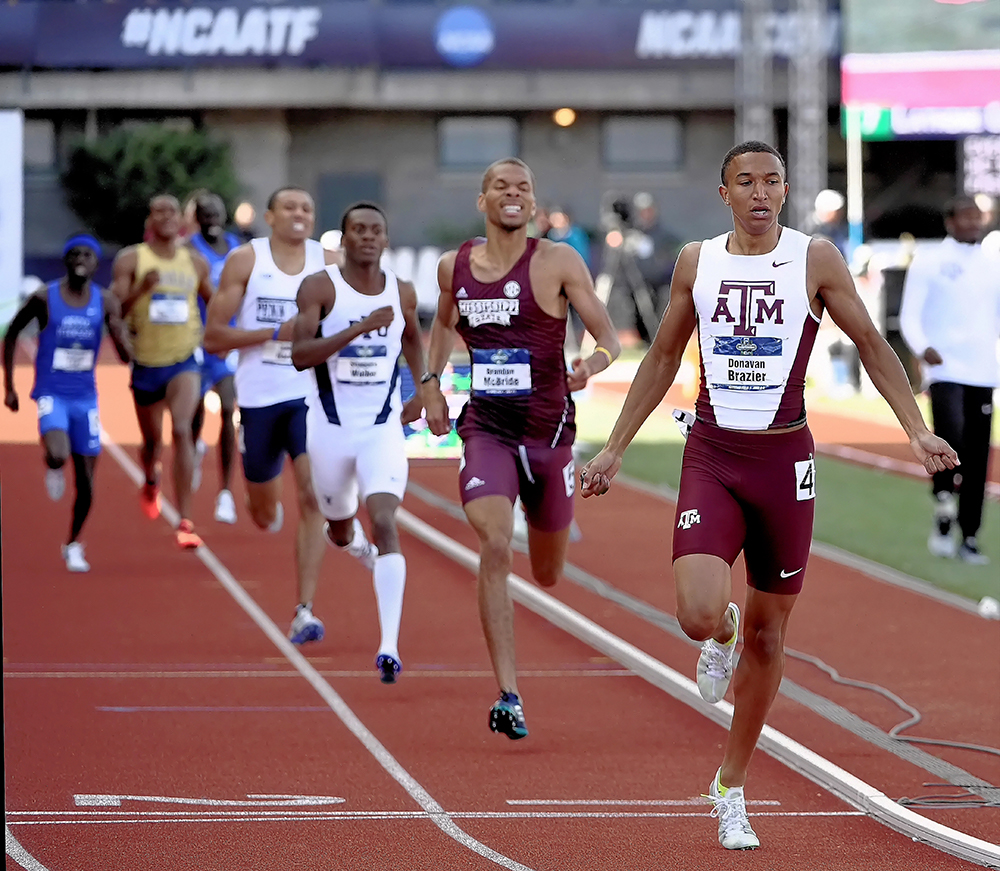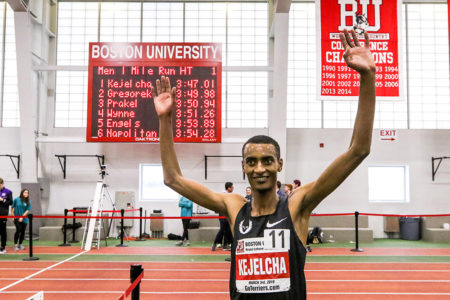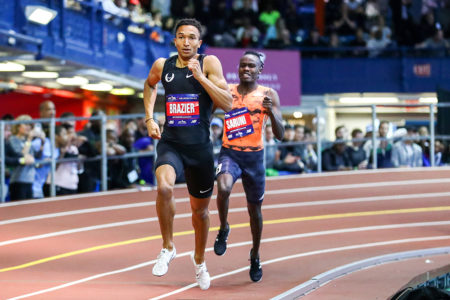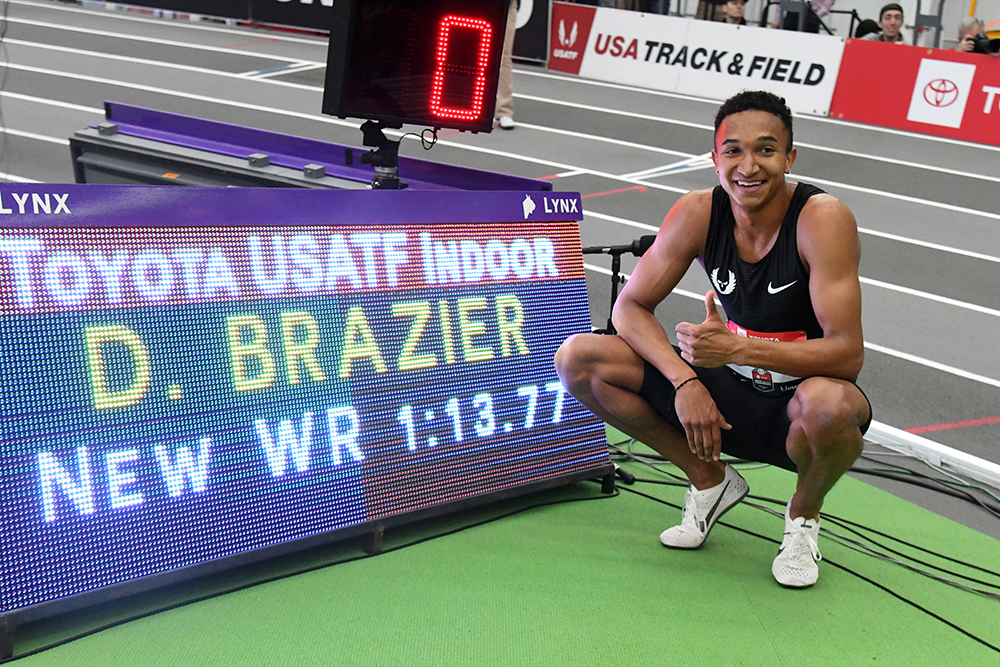
FROM THE SIDELINES of the ’18 outdoor season, Donavan Brazier bounced back with a record-setting indoor campaign this winter, taking down the 800 AR and the WR in the 600, surpassing his own expectations before the year began as he became our American Men’s Indoor Athlete Of The Year. Ever since the Michigan native broke the American Junior Records in his specialty event as a Texas A&M frosh, he has been a 2-lapper full of promise. Brazier moved fast in that Olympic year, running faster than the indoor AJR in January and surpassing Jim Ryun’s outdoor U20 standard on its 30th birthday at the NCAA Champs. Brazier turned pro immediately and despite flashes of brilliance—notably missing Johnny Gray’s indoor 800 AR by 0.01 last year—is among the first to admit he often ran himself into frustration: not his day for the ’16 Olympic Trials heats and ditto for the ’17 World Champs semis, not to mention being DQed from his ’18 World Indoor heat.
Then an Achilles injury took him out of the running for all of last spring and summer. As sponsor Nike steered Brazier to medics for help, he rubbed shoulders with the swoosh company’s Oregon Project team and decided to join them under coach Pete Julian. The NOP’s middle distance group is full of aces—Rio medalist Clayton Murphy, Craig Engels, Eric Jenkins—and Brazier opted to throw his hat in their ring. He got a very late start on training for ’19 but produced his best winter season yet.
We reached him in College Station after his undercover campaign wound up, getting in a patch of R&R before the buildup for outdoors.
T&FN: It’s striking that you ran the AR with a very different tactic, taking it out from the gun, than you used to almost break the AR last year. Why did you make that choice?
Brazier: I knew I could break it. I just think the American Record indoors has never really been anything crazy. That’s because if you look back at Johnny Gray and Mark Everett and all those guys that used to run indoors, they never really took it this seriously, let alone being able to run on a 200m track a lot of times. So I think that just kind of put it in the back of my mind last year. Coming within a 10th of a second three different times without achieving it really hurt. So I really kind of wanted to get the monkey off my back this indoor season.
T&FN: That makes sense. Our colleague Jeff Hollobaugh, who lives in Michigan, pointed out that your signature racing strategy in high school was the big kick, hanging back early to win with a hard finish. You’ve stuck closer to the front as a collegian and pro, and for the AR Millrose you front-ran. What are your thoughts on tactics?
Brazier: I think when you’re in good enough shape, you’re in good enough shape. In high school when you’re just kind of a level above everybody—which I kind of was—just because of the talent you have in your area, it’s easy to kind of run whatever it takes to get to the final. Then comes college and you’re running against competitive guys and in order to beat them you have to run fast, you have to kind of run it your way.
But I’m learning after joining the Oregon Project and learning the way that they race, that Coach Julian doesn’t want me to be predictable as a racer. He wants to give me the confidence of knowing that I can win from any place I am, from whatever position I am in the race—that I just can’t panic like I’ve been known to do in the past. Especially through the preliminary rounds where I’ve sat when I’m in the right position. Sometimes I’d feel like I was just kind of out of the race from the get-go. There’s kind of been more strength [work] that we’re doing there, just knowing that I have the ability to run out front alone as well as just run from the back. It kind of works out in any way.
I think that the new thing with me—the first meet I ran this year [a 600 at Texas A&M], I was in 3rd-place [through the first 200 and well into the second lap] and that was kind of different for me, especially when we didn’t have a rabbit in the race. The idea behind that was just to be able to run in different ways. I think when you have different weapons and you have all kinds of different ways to race and maneuver it makes you more unpredictable. I just don’t want to be a predictable runner like I used to be.
T&FN: Did getting past the Achilles injury—I saw you in mid-October and you said you were still struggling (October ’18 video interview here)—limit what you were able to do and the time you had to prepare for indoors?
Brazier: The Achilles thing was kind of weird. Once I had the Achilles problem it just kind of spread throughout my lower leg and down and all. So if one thing got fixed, something else was off. So if my Achilles was on, my ankle was off. My flexor hallucis longus [a muscle in the foot] was kind of irritated through that whole thing. I finally just kind of told myself, I finally stopped doing all this treatment on it. Guys were being aggressive on it, guys were always digging into it talking about how, “I know how to fix it.” That kind of hurt me. Your body knows how to heal itself and I finally gave it a lot of time to heal itself. Your body doesn’t want to become limp and not know how to recover. Your body can recover itself but I just never gave it the right amount of time or did it the proper way. I finally did that come later in the year.
In 2018 even after the season at some point I was thinking, “Hey, I might run the 5th Avenue Mile,” so I was always trying to train hard. Running on concrete and everything that was bad for it, I was doing it just in the hopes that I’d be able to run later on in the season. Which was really stupid, when you think about it. I kind of just took a move in October and November and coach Julian was like, “What are you training so hard for right now? What are you doing? Worst case, if you’re not fit for indoors, you miss indoors, that’s not the worst thing in the world.” He just kind of explained it to me and we finally took our time with things and I just gave myself about a 1-month period in November: “OK, on December 1st I’m gonna start to run.”
I think I took all of November off, not doing anything but cross-training. All the way from June, July all the way up to October, everything between there just wasn’t really helping. So I finally took a 4–5 week period. Once I did that I think kind of building up the strength in my lower limb helped.
T&FN: So you started running in early December and ran your first race, that 600 at A&M, on January 19. That’s a rather abbreviated training period but everything from then on went well.
Brazier: Yeah, it worked out pretty good. Better than I think we expected and anticipated because at first we were just running these meets to see how my Achilles would respond to it, but eventually we saw that my Achilles and my ankle were fine and we just took it step by step. At first it was the A&M meet, then Boston, then Millrose, and we decided to run USAs. In the 4 weeks leading up to USAs we weren’t even planning on running it. There was just kind of a domino effect. I’d attribute that to the warm weather and the camp that we did out in Phoenix. I think that helped a lot.
T&FN: You were in Phoenix. Did you spend any time at altitude?
Brazier: No, we don’t really do altitude. For 800m runners it really doesn’t benefit as much. Pete Julian and some of us were in Phoenix and the rest of the guys were still in Portland. Suguru [Osako, the marathoner] was out in Flagstaff and Eric Jenkins, Craig Engels and myself were out in Phoenix training.
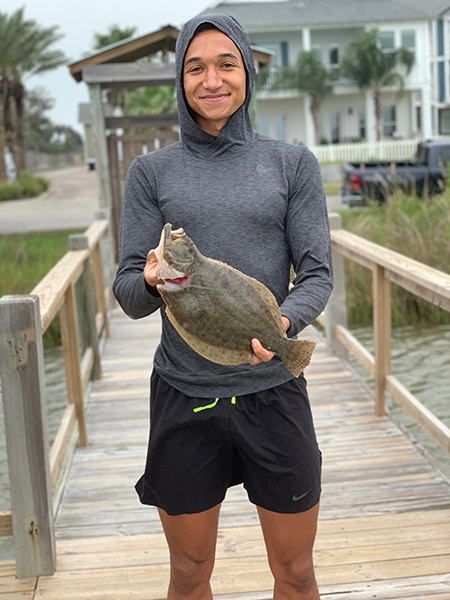
T&FN: So what’s next?
Brazier: I’m actually going to take a fishing trip down in Corpus Christi. Any time after that I’ll probably head back up to Portland. Just because we have all the resources up there. That’s our base, our headquarters. I’ll probably head back up after a week or two.
T&FN: Will you be deep ocean fishing?
Brazier: Yeah, for the first time I’ll do some ocean fishing on a friend’s boat out there so that should be fun.
T&FN: What fish are around to be caught this time of year, do you know?
Brazier: Dude, that’s the thing I don’t know. I’m just a Michigan boy so I’ve never even fished areas where the fish are that plentiful. I have been down to Clearwater before, in Florida. We’d fish off the pier, we catch all sorts of things like jackfish and sea trout and all these other fish, but every time we catch something I’m just not familiar with it.
T&FN: One’s supposed to ask fishermen, what’s the biggest fish you’ve ever caught?
Brazier: Everybody asks me. I feel like it’s a really disappointing answer every time. It’s probably a 3-foot catfish off the channels of Lake Michigan. It’s pretty fun fishing.
T&FN: Good eating, too?
Brazier: Oh, yes, definitely. You gotta fry ‘em, they’re really good.
T&FN: You’re a hunter as well, yes?
Brazier: I did all sorts of hunting growing up: Squirrel, rabbit, deer. Duck, I got into that lately.
T&FN: With this season running as late as it will, I can imagine getting some down time right now is really important.
Brazier: Yeah, with them switching up USAs a whole month back, it really does change everything. You can’t really just transition from indoor to outdoor season the way you usually do. Pete, the coach at the Oregon Project, he recognizes that and he just kind of said, “Even if you don’t physically feel tired, you’ll mentally feel tired and it’s good to take a break.” Just in case, because we have time to get into fit racing shape again.
T&FN: Setting a World Record in almost anything must be rewarding. Which of your races this winter are you most proud of?
Brazier: Probably my 600 at A&M. Because I hadn’t raced in almost a year at that point and I had good competition. I had Deon Lendore, he’s a [400] bronze medalist in 2012. Carlton [Orange] was in good shape and JaQwae [Ellison], both were my roommates. I didn’t really know what kind of shape I was in. I really didn’t have much track training or sessions down. So it was kind of going into it blind and coming out the other end good. I knew it was going to be a good season, and my Achilles held up. I was really happy with that because I know if my body’s right and my mind’s right, everything else is going to fall into place. So all the other stuff that happened later was kind of just meant to happen at that point.
T&FN: With your only regret being not beating Saruni, do you think there’s anything you could or should have done differently?
Brazier: I think it’s just heart and lungs. They were not where they needed to be at the time. He’s a guy I think that was more fit and had better training than I at the time. I definitely would think I have potential to beat him but so far I haven’t really shown that much. I would have liked that meet to have been it. But I know that if he would have taken it out, the result would have been the same. So to run any differently, I’d say not, but do I wish I would have beat him? Yeah. But to beat him I think I would have had to rise above.
T&FN: Do you and your NOP teammate Clayton Murphy train together much?
Brazier: Just in general we haven’t done much training together because I’ve been hurt for the majority of the time I’ve been with NOP. But [more recently] on days I wasn’t training on the track we did our long runs together and we got in a few track sessions together, and it looks like we’re going to keep on doing that throughout this season now that everything’s going well.
T&FN: I guess the story will unfold going forward, but you have a reputation as a speed-oriented 800 guy and a relatively low-mileage trainer with Clayton more of a traditional 800/1500 runner. You’ve run a sub-4 mile so the distinction may be overstated, yet Clayton ran some impressive college cross country over 8K. Are your training programs quite different?
Brazier: Yeah, sure. I still don’t really count my mileage to this day, but I’m sure he’s run more mileage than me. I’m actually positive about that. (continues)
T&FN: Are you finding you mesh well with the NOP group?
Brazier: Yeah, it’s going really well. I like these camps a lot. We come home to each other and we have long runs together nearly every single day, so I think being around them in the camps we’re really able to focus and have no distractions.
T&FN: When you’re not training or recovering, do you hang out? Any recreational activities to break up the days?
Brazier: What do we do to entertain ourselves? Anything we think won’t hurt our running. We have tennis courts and pools, all that fun stuff, so it kind of seems more like a resort than an apartment complex at some points. But it was fun. Craig got me into disc golf, throwing the frisbee and it was really fun.
T&FN: Craig’s vintage Toyota camper’s gotten some press lately. Did that make the trip to Phoenix?
Brazier: Yeah. He has, I think a 1989 Dolphin is what it’s called. It’s a piece of crap, honestly I think, but it runs and it made it all the way down from Portland to Phoenix, and Pete would take it to Flagstaff and back, and we’d go wherever we needed to go in it. It’s not my style but it was pretty fun; it’s definitely Craig’s.
T&FN: What’s your style for transportation?
Brazier: I’ve got a Silverado, actually, a Silverado 1500. That’s my kind of stuff, more outdoorsy, but you won’t catch me around an ’89 Dolphin RV.
T&FN: Some people posit that the 800 is the most demanding race in a tactical sense, with the least room for error. Do you agree?
Brazier: Yeah, I agree with that. It’s the hardest race tactically but not painfully. The reason for that is it’s the shortest that’s not a sprint and it’s the shortest race where you don’t have your own lane. You can get caught up in between people. I’d agree it’s the hardest tactical event, I don’t think it’s the most painful. And there’s less room for error, too, in the 800 as opposed to the mile. In the 1500 you’ve got 3 minutes or 3:30 to make it up. But at 800 speed it’s kind of hard to make it up.
T&FN: Do you have any aspirations as a miler?
Brazier: To compete, I don’t think I’ll ever get to the 1500 but just to incorporate that into my training I’m sure I’ll run some 1500s this year along with some 400s. I’ll probably run a 1500 and a 400 before I even open up in the 8.
T&FN: Do you have any idea when you might run those races?
Brazier: If I had to guess, I’d say maybe Payton Jordan at Stanford. The NOP guys like to hop down there real quick because it’s close to Portland, a quick flight. I’m sure Clayton and Craig will be in it and maybe Eric if he’s healthy.
T&FN: What do you see as the most important thing you want to accomplish this season?
Brazier: I think what I want to accomplish the most is just making the transition from trying to be this frontrunner that always wants to run fast and just always relies on running fast to win into this runner that can be tactically savvy and win any way. I think that would be a huge improvement. And I haven’t run an outdoor race in year and a half. My last outdoor race was London [the World Championships semis]. I took the entire outdoor season off last year so I think I’m really just here to compete this year and I want to make the transition as smooth as possible.
T&FN: Assuming you make the Worlds team, do you have any idea what you’ll do between USATF in late July and Doha 2 months later?
Brazier: I don’t know. I know they have Pan-Ams this year and the selection process that they have this year is that the top 2 times will have the opportunity to decide if they want to declare in it or not. So if I get the opportunity to run Pan-Ams I might do that but that’s something I haven’t even talked much about with coach Julian. But when he mentioned it I think he kind of liked it. When you are focused on trying to win a gold medal at Worlds you don’t want to over-race yourself. Especially with the season so late, you want to make sure that your great races are the ones leading up to Worlds and you’re not just out for some of these Diamond League races and World Challenge meetings. (continues)
T&FN: Did you play other sports as a kid?
Brazier: Yeah, I did a lot of football and basketball, actually. Those were my two other sports, that’s what I really enjoyed doing. I still do enjoy doing but obviously with trying to keep your body healthy you’ve got to limit what you can do so I’ve kind of stepped away from football and basketball and all that. I wish I could play more football, though. At USAs, this last indoor, I actually told my coach I could play wide receiver if I really put my time and effort into it. Vashti Cunningham was high jumping and her dad, Randall Cunningham, happened to be talking to my coach too. And my coach said, “Hey, Donavan thinks he could be a wide receiver in the NFL if he really tried to.” Randall Cunningham said, word for word, “I think he could.” I was really proud, even running that meet, because I wanted to be a wide receiver at that moment. Word for word, but he’s just a Hall Of Fame quarterback. He’s one of those guys that makes me want to follow that path and hear their dreams, but that’s probably not where I’m gonna go.
T&FN: Maybe if you win an Olympic gold you can give it a try. Did you play high school football?
Brazier: I played freshman year. I didn’t do anything after that. I didn’t even play freshman basketball. I stopped after that, I was the smallest kid on the team. Like I’ve said, I was a late bloomer and just decided to run cross country, which was one of the stupidest decisions I’ve ever made [laughs]. I thought, “Football’s too much pressure, it hurts too much, I want to run cross country.”
T&FN: Didn’t you run a 45.92 relay leg anchoring for your high school team?
Brazier: Yeah, I did. That was at a conference meet my senior year. That was the fastest 4×4 split I ever ran in high school. We were way behind, losing the meet and getting our butts kicked. We were way behind, 40m or so, and it was just a conference meet. The rest of the guys there were splitting 52s, stuff like that. Not anything that impressive there but it was under the lights, it was a late meet, no wind and the weather was right and, yeah, I split a 45.9. The week before I split a 46-low [46.16] so I knew a 45 was possible. I didn’t realize I did that until after the meet but we won the race. Me and the other guy both ended up falling over the finish line.
T&FN: Any aspirations to improve on that?
Brazier: Yeah, I’d like to make a U.S. team in the 4×4. I think that would be kind of nice but it’s sometimes hard moving down from the 8 to a 4. You’ve gotta have some incredible foot speed for that. I couldn’t compete in a Diamond League 400 right now. I just don’t think it’s there yet.
